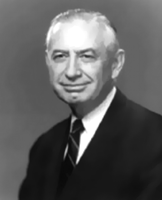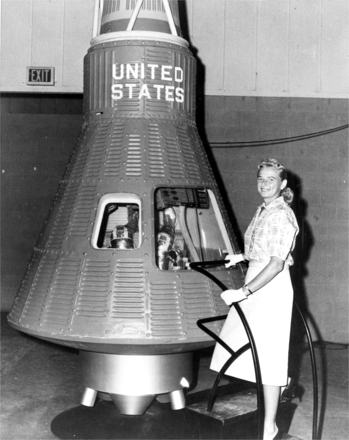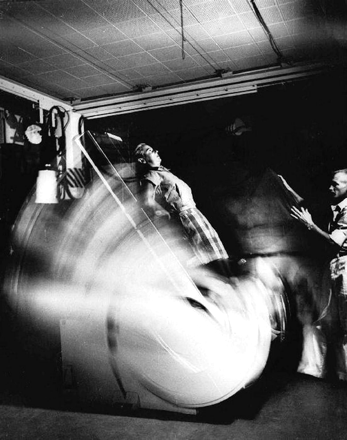You've heard of the Mercury 7 astronauts; they became the backbone of the NASA program and inspiration to an entire generation of young people. But you may not have known there were also a Mercury 13 - and they were women.
In the early years of the space race two men sought to test a scientifically simple yet culturally complicated theory - that women might be better suited for space travel than men.
In 1960 a woman in space instead of a man was a revolutionary idea: 75% of American women did not work outside the home and females were banned from military flight service. Wives were required to have their husband's permission to take out a bank loan, buy property, or purchase large household goods such as a refrigerator.
But not everyone had those same cultural biases and so a Harvard-educated surgeon and a U.S. Air Force General sought to determine if, from a purely practical perspective, women were suitable for space flight.
The Mercury 7
In 1957, the Union of Soviet Socialist Republics (USSR) launched Sputnik, the first unmanned orbital satellite, thus formalizing the race for space. The following year the U.S. government established the National Aeronautics and Space Administration (NASA) and in April 1959, NASA introduced the seven men who would comprise the first American astronaut group, better known as the Mercury 7 crew.
Individually, the Mercury members made six flights between 1961 and 1963 of which two would reach space, defined as 62 miles above earth. In 1962, John Glenn became the first American to orbit the earth.
Two Men's Vision for Space
Sometime before the mid-1950s two men had begun to seriously discuss the possibility of sending a woman rather than a man into space. One of the men was William R. ("Randy") Lovelace, II, a Harvard-educated physician, surgeon and aeromedical physiologist. During his years at the Mayo Clinic Lovelace co-developed a much-needed high altitude mask that delivered oxygen to pilots while in flight. At the time, aircraft cabins were not pressurized which lead to hypoxia-induced errors and accidents by pilots.
Upon leaving Mayo he established the private Lovelace Foundation for Medical Education and Research, which received government contracts throughout the '50s to conduct aerospace research. Lovelace was also among the team of experts who developed the physiological, medical and psychological criteria by which astronaut candidates were assessed and selected, including the Mercury 7 team.
W. Randolph Lovelace II, as he appeared at the time of the Woman in Space Program. [From the National Aeronautics and Space Administration (NASA).
General Donald Flickinger, Air Force chief of bioastronautics at the Air Force Air Research and Development Command (ARDC), was a member of the NASA Special Advisory Committee on Life Sciences and a friend and oft-time collaborator with Lovelace. In 1959 Flickinger established the Woman in Space Earliest (WISE) program at ARDC. Thereafter, he and Lovelace began to contemplate plans for testing women in space.
Their proposition was based purely on physiology and practicality. They recognized that women's lighter weights would reduce the amount of propulsion fuel being used by the rocket's load and that women would require less auxiliary oxygen than men. They knew that women had fewer heart attacks than men and their reproductive system was thought to be less susceptible to radiation than a male's. Finally, preliminary data suggested that women could outperform men in enduring cramped spaces and prolonged isolation.
The Mercury 13 Women
Before WISE testing could begin the Air Force announced that it would no longer pursue the program. In response, Lovelace established a privately funded effort, the Woman in Space Program, in 1959. A total of 19 women were enrolled, most of whom had been selected from flight schools.
The women underwent the identical tests that the male candidates had undergone. In the end, 68% of the women passed with "no medical reservations" compared to 56% of the men. The 13 females who passed were known as the Mercury 13. They were Bernice "Bea" Steadman, Janey Hart, Geraldine "Jerri" Sloan Truhill, Rhea Allison Woltman, Sarah Lee Gorelick Ratley, Jan Dietrich, Marion Dietrich, Myrtle Cagle, Irene Leverton, Gene Nora Jessen, Jean Hixson, Wally Funk and Geraldyn "Jerrie" Cobb.
Lost and Found: Data on Female Applicants
The data collected from these women from their physiological testing were never published and had apparently been lost. Dr. Loeppky, one of the co-authors of the article, had worked with Dr. Ulrich Luft, an eminent physiologist who had performed the original aerobic exercise capacity tests on both the female and male astronaut candidates. For the first time, the current paper summarizes these physiological data, demonstrating that the aerobic capacities of the top four women were comparable to those of male pilots of the time.
Jerrie Cobb
Jerrie Cobb was the first female to volunteer for the program. Having taken up flying at just age 12, she held numerous world aviation records for speed, distance and altitude, and had logged more than 10,000 hours of flight time. Of the Mercury 7 astronauts, John Glenn had the most flight experience at a total of 5,100 hours.
Cobb had undergone a standard battery of personality and intelligence tests, EEG and neurological tests and psychiatric interviews. On the final day of advanced testing she was immersed in a soundproof isolation tank filled with cold water in order to induce total sensory deprivation. Based on previous experiments in several hundred subjects, it was thought that six hours was the absolute limit of tolerance for the experiment before the onset of hallucinations. Cobb, however, spent more than nine hours in the water, before the staff terminated the experiment.
Geraldine ("Jerrie") Cobb beside a Mercury capsule. [From NASA.]
All told, Cobb had tested in the top 2% of all tested candidates, male and female. In May 1961 Cobb received an informal invitation to undergo spaceflight stimulation training at the U.S. Naval School of Aviation Medicine in Pensacola, FL. After ten days of testing, she had scored as well as experienced Navy pilots and plans were made to test the remaining 12 women.
Jacqueline "Jackie" Cochran
Jackie Cochran was the leading woman in American aviation in 1960. During World War II, she founded and led the Women Airforce Service Pilot (WASP) to fly military aircraft domestically (thus freeing up male pilots for combat service). In 1953, she was the first woman to break the sound barrier. Although she knew of the Woman in Space project, and did not meet the qualifications for testing, she believed she had been deprived of a leadership role in the program. In the end, however, she and her husband agreed to fund the Pensacola testing for the 12 women.
The End of a Vision
Despite Cochran's funding and the promising results, the Pensacola testing had not been authorized and the military would not move forward. Lovelace could not pursue the Woman in Space program further. Cobb assumed the de facto leadership of the women and began extensive lobbying efforts. In a meeting with then-Vice President Lyndon Johnson, he expressed no support for the program.
Jerrie Cobb on tilt table at the Lovelace Foundation in 1960. "A Forgotten Moment in Physiology: The Lovelace Woman in Space Program (1960-1962)," Kathy Ryan, Jack Loeppky and Donald Kilgore, Advan. Physiol. Edu. 33: 157-164, 2009; doi:10.1152/advan.00034.2009
Embittered by her experience Jerrie Cobb continued to lobby until 1965. For the next five years she flew missionary operations in the Amazon and in 1980 was nominated for the Nobel Peace Prize for her efforts. It would be more than 30 years after the testing that 11 of the 13 Mercury women would be reunited. This time, 1995, they came to watch Eileen Collins pilot the first flight of the joint Russian-American Space Program.
Conclusion
The vision of Lovelace and Flickinger to launch the Woman in Space Program in 1959 was remarkable not only for the science it attempted to discover, but for the times. The combination of this ingenuity and the capability and willingness of the women in the program ultimately allowed the space program to advance as far as it did.
Article: "A Forgotten Moment in Physiology: The Lovelace Woman in Space Program (1960-1962)," Kathy Ryan, Jack Loeppky and Donald Kilgore, Advan. Physiol. Edu. 33: 157-164, 2009; doi:10.1152/advan.00034.2009






Comments